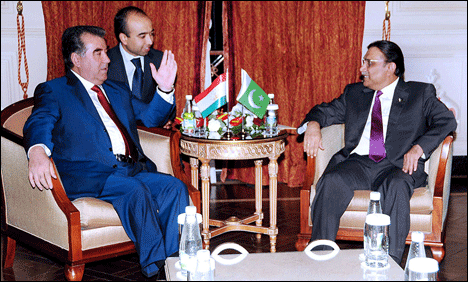
Tajikistan and Pakistan at a Crossroads: Energy, Trade and Transport Across Central and South Asia
Publication: Eurasia Daily Monitor Volume: 8 Issue: 21
By:

Pakistan and Tajikistan have actively advanced their partnership in the energy, trade and transport spheres in recent months. The three pillars of cooperation are crucial components of the national strategies of these countries in bilateral and multilateral formats as they seek to break their relative isolation from regional and global markets and influence security trends unfolding in Central and South Asia. It is in these regions where they have disagreements with their neighbors, Uzbekistan and India. They also potentially face the threat of instability spreading from Afghanistan.
In December 2010, Tajik President, Emomali Rahmon, and his Pakistani counterpart, Asif Ali Zardari, met on the sidelines of the Economic Cooperation Organization summit in Turkey. The meeting was preceded by bilateral talks in November 2010 in Dushanbe between Rahmon, Tajik Prime Minister Okil Okilov, and Pakistani Prime Minister Syed Yusuf Raza Gilani. These meetings aimed to boost cooperation in the energy, trade and transport spheres across Central and South Asia (www.pak-news.net, November 25, 2010; www.asiaplus.tj, November 25, 2010). Both countries are considering building electricity supply networks to Pakistan and transit corridors via Tajikistan, and plan to establish a joint business forum to facilitate investment and trade (www.allvoices.com, October 11, 2009).
Okilov said that bilateral trade reaching $6.5 million in 2009 was still low, and invited Pakistan to invest in the country’s hydroelectric projects. Okilov emphasized that cultivating relations with Pakistan was one of the main priorities of Tajikistan’s foreign policy (www.thedawn.com.pk, November 25, 2010). Zardari stated that Pakistan was ready to help Tajikistan strengthen its defense capabilities and develop its hydroelectric resources, adding that it was important to “jointly persuade Afghanistan on a new route with Tajikistan through Wakhan” (www.nation.com.pk, December 23, 2010). Last July, Gilani said the existing Pakistan-Afghanistan transit trade agreement had the potential to extend to Central Asian states, and that Islamabad would consider providing Tajikistan with land at Gwadar and Peshawar Exclusive Free Zones in exchange for land to Pakistan in the Tajik Punjkoi Free Zone (www.app.com.pk, July 27, 2010).
Tajikistan reportedly faced a railway blockade by Uzbekistan, which impedes the imports of materials needed for the construction of water dams (www.dw-world.de, January 5). Downstream Uzbekistan views Tajik hydroelectric projects, especially the Rogun dam, as threatening its economic security. Tajikistan insists such projects would ensure the country’s energy security and development. Pakistan offered to invest $600 million in the Rogun project in the early 1990’s, but the Tajik civil war ensured that the investment would not materialize (www.centralasiaonline.com, May 3, 2010). Tajikistan currently imports most of its cement for construction from Pakistan, which plans to create new enterprises in the country, including a cement factory (www.regnum.ru, January 6; www.asiaplus.tj, November 25, 2010).
Pakistan wants to break its relative isolation. Islamabad is concerned with Indian military inroads in Tajikistan. New Delhi helped renovate the Ayni airbase following the trilateral agreement with Russia and Tajikistan in 2002. While India is unlikely to establish its first overseas military foothold in Central Asia given Russia’s preponderant regional security role, its military cooperation with Dushanbe is a significant factor driving Pakistan’s active collaboration with Tajikistan and others in the region. Moreover, Pakistan does not have direct trade links with Central Asia. Pakistani goods have to pass through the Suez Canal to the Black Sea and then cross several countries by rail before they reach the region. Nor does Pakistan have beneficial trade arrangements with India. Informal annual trade between them is around $2 billion to $3 billion, with Pakistan accounting for less than 0.5 percent of India’s trade while the latter accounts for around 1 percent of Pakistan’s trade. Yet, this trade could increase by as much as 20 times if bilateral relations are normalized (www.eastasiaforum.org, April 19 2010). Cooperation with Tajikistan offers Islamabad many prospects for expanded intra and inter-regional trade through Pakistan.
Indeed, Tajikistan is only separated from Pakistan by the north-eastern Afghan Wakhan corridor linking Tajikistan, Pakistan, and China. It is this corridor, which used to serve as a buffer zone during the Great Game between the Russian and British empires in the nineteenth century that Dushanbe and Islamabad, along with Moscow and Kabul, plan to utilize to enhance cross-regional trade by constructing a road and a railway link between Pakistan and Tajikistan. The plan is of strategic importance as it would provide Tajikistan and Russia with access to Pakistani ports and, hence, the Arabian Sea and the Indian Ocean, while expanding trade for Pakistan and Afghanistan in and via Central Asia into Russia and other countries. The possibility of the corridor being connected to China via the Karakorum highway makes the initiative potentially more lucrative (www.inosmi.ru, September 9, 2010).
Dushanbe and Islamabad, with Moscow as well as international financial institutions, also plan to bring electricity from Tajikistan and Kyrgyzstan to Afghanistan and Pakistan in the framework of the $640 million Central Asia-South Asia-1000 (CASA) project (www.tajikembassy.pk, April 23, 2010). Rapidly emerging India may join the initiative later, benefiting Central Asian exporters. Pakistan and India are already collaborating on TAPI deal seeking to deliver Turkmen gas to Afghanistan, Pakistan, and India.
Energy, trade, and transport initiatives pursued by Pakistan and Tajikistan reflect both the opportunities stemming from cooperation and potential challenges of non-cooperation as NATO scales down its operations in Afghanistan. Yet, as Tajikistan expands its links with South Asia, Central Asia may well encounter more security risks associated with Islamic fundamentalism, terrorism and drug-trafficking. In 2009, Dushanbe initiated the creation of a security quartet (Russia, Pakistan, Tajikistan and Afghanistan) to combat the drug problem. The four countries also participate in the above-mentioned initiatives (RIA Novosti, December 19, 2010). Russia is now considering the possibility of sending its border troops to Tajikistan, while Washington is planning to open a military training center in Tajikistan (www.ng.ru, December 13, 2010). Working with Pakistan and Tajikistan is crucial for the security and geopolitical interests of both Moscow and Washington in Afghanistan and the broader region.
Islamabad and Dushanbe thus find themselves at a crossroads of significant regional initiatives in the fields of energy, transport, and trade, which could promote long-term security and development as well as linking Central and South Asia, despite security risks in the short-term. They may facilitate the normalization of relations between Dushanbe and Tashkent, Islamabad and New Delhi as the respective countries value the benefits of expanded trade. The Wakhan and CASA projects are a reflection of remarkable dynamics where a lack of intra-regional cooperation in Central Asia seemingly drives inter-regional cooperation with South Asia for Tajikistan, and similarly for Pakistan, with a potentially beneficial impact on the intra- and inter-regional trade for current rivals and partners alike.




